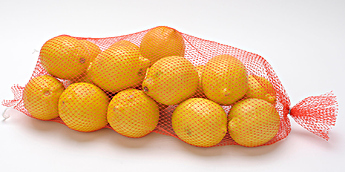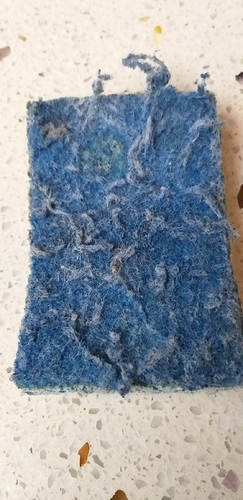These double-sided sponge/non-scratch scourers are very useful in day to day food preparation and cleaning up but within a few days the scourer falls apart long before the sponge. I have tried all of the common brands available in supermarkets but they are all disappointing. The shiny silver scouring pads are not much better.
I have subscribed to Choice for 40 years and my parents before that. I cannot recall a testing of these products. Any ideas?
I have looked at the Choice website and can’t see any specific testing of scourers. I think your suggestion for a test is a terrific idea.
I concur, although I use dishcloths and seperate scourers.
I have tried a range of green scourers and find that they disintegrate; some rather more rapidly than others.
Like this one?
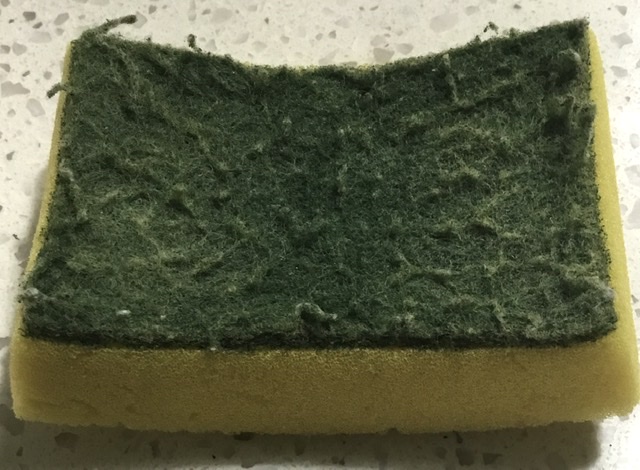
Chux, Scotch-Britt, Woolies Essentials HD.
All three seam to stay together in our sink, per this one used mostly for the pots and pans daily. It is obviously well used and has done many weeks. Dishwasher for the everyday crockery etc. Back in the old days it was a not uncommon issue for the green scourer to depart the sponge. We have no memory of this in recent years.
It’s still worth a test as the scourer pads seem to differ in texture, life and effectiveness across brands.
As a thought perhaps the water temperature or detergent are factors. We only use septic safe DW liquid. Earth Choice preferred. Hot water is a gas instantaneous (mounted on kitchen outside wall) which is preset to 50C per regulation for whole of house. Note 60C is the maximum permitted for kitchen use or laundry. Some domestic experts apparently prefer scalding hot water, via boiling kettle or other solution.
It is perhaps easy to test the adhesion by a high temperature water bath soak test at 60C?
I make mine from orange nets (upcycled)–the tough ones that usually hold 3kg. They last a very long time (3+ years), work as well or better than bought scourers, and don’t scratch surfaces.
I can post instructions if anyone is interested.
Yes please, I’d like to make one. Greg
I’ll second that.
Beware green kitchen scourer pads. They usually contain carborundum (Silicon carbide) which is very hard and used as a grinding paste and in ‘sandpapers’. It scratches the surface of stainless steel, enamel, vitreous materials (glass, casserole dishes etc) and other materials which leaves them finely scored so they are more difficult to clean. So a Choice test of scourers should measure the damage they do to the surfaces they might be used on.
No-one has yet invented a better scourer than water and a fingernail.
I’m sorry I don’t have photos of the process. The next time I make one I’ll take photos along the way.
This is the type of bag to use–3kg orange bag–not the smaller and finer ones used for avocadoes, onions etc.
If you have a choice, get a bag with no label glued on, or a label that easily tears off.
- Open the bag by cutting an end off rather than making a hole in the bag.
- Cut off the other end as well. (If the end is sewn, you might be able to unpick the stitches to maximise the amount of mesh you have.)
- Remove labels. Tear them off gently if possible. Otherwise cut them off, preferably without making holes in the bag. If you don’t care how it looks, then leave little bits of label attached as necessary. If you end up with a lot of holes, avoid Method 2.
Method 1. The easier way.
-
Cut the mesh tube in a spiral, aiming for 4-5cm width. (As you would peel an apple if you were aiming for one long piece of apple peel.) Accuracy is not important.
 How to cut the bag
How to cut the bag -
Cut your long piece of netting into 3 equal lengths.
-
Firmly clip the three pieces together at one end (paper clip, safety pin, bulldog clip etc). Attach this end to the back of a chair (with some string?)
-
Plait the three pieces together making the plait as flat as possible. When you reach the end, tie two of the strands together so it won’t unravel.
-
Remove your plait for the chair, remove the clip, and tie two strands together at the clip end.
-
Wind your plait into a spiral, keeping it as flat as possible.
Using a large needle and tough thread (fishing line, polyester thread, or string) stitch the sides of your plait together to make a flat spiral.
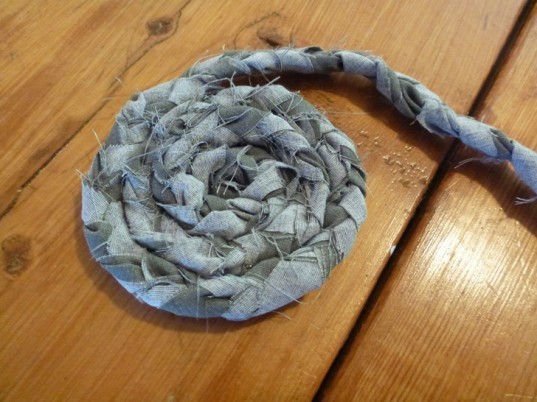
That’s an example using fabric.
Method 2. The Harder Way using crochet*
Large crochet hook (10-12mm)
- Prepare your netting as for Method 1, Step 1, but cut the mesh tube into a 25mm wide strip. You should have ~7m.
- Make a loop in the end and chain 4. Slip stitch into the first stitch to join the loop.
- Ch 1. Hold the tail next to the loop so it’s crocheted in as you go. Double crochet (DC) 14-15 times into the centre of the loop until your piece is flat.
- Slip stitch to join to the first DC.
- Chain 1, then 2 single crochet (SC) into each stitch around the circle. (If you are running out of netting, instead do 1 SC and 1 chain then repeat). Join. Ch 1, and pull netting through the last stitch. Sew the end in using a tapestry needle or weave in using the crochet hook.
[Video instructions here for the crochet pattern, using tulle instead of upcycled mesh. Finish at 5:00.]
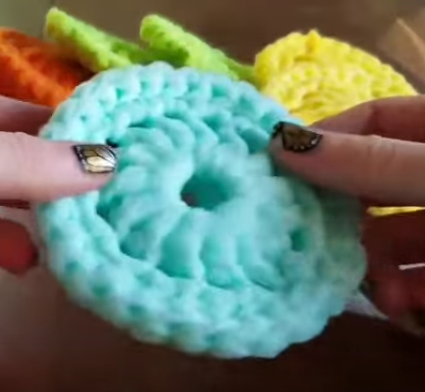
It will look something like this (but nowhere near as neat).
Notes.
-
Method 2 is harder as the mesh is very difficult to work with. I’ve tried knitting as well as crochet, and knitting is harder again since there are two needles to wrangle with the mesh.
-
I’ve also tried using the thinner, softer mesh bags (used for onion, avocadoes etc) and they are not suitable. They shed a lot of plastic when being used, and are not very tough.
Discovered these when living in the UK. My current one (pictured) has been going for at least 12 months and is still going strong, no sign of falling apart. Scourer (non-scratch) is starting to wear out, but probably still good for another few months. These used to be pretty hard to get in Australia (I was buying them from the UK via ebay) but they are now available from Everten, Victorias Basement, Peters of Kensington, etc.
Is this the same thing, or something different? https://www.spotlightstores.com/kitchen-dining/kitchen-cleaning/white-magic-washing-up-pad/BP80385341
Different. I tried one of them, didn’t like it - very floppy, difficult to get the whole thing to stay in contact with whatever you’re trying to wipe/scrub.
Thank you! So, is this the one? https://www.amazon.com.au/cloth-Washing-Up-Pad/dp/B002KQ5CK0/ref=pd_ybh_a_2?_encoding=UTF8&psc=1&refRID=KD04HE7WEBNJQERM82JV It actually cheaper! 
That’s impressive for 12 months wear
Yes that’s the one. Other places that sell it:
https://www.everten.com.au/e-cloth-washing-up-pad.html
And also available on eBay
I just opened a new Chux non-scratch blue scourer a week ago, and I’d used it for barely two days before the scourer started to peel off the sponge. A few more days and their separation is complete!
I now use Aldi sponge scourers and have found that they seem to last longer than the others. They are called Power Force Cellulose NON-SCRATCH Sponge Scourer Packet of 3.
I use stainless steel scourers. Not perfect but they last a long time and the big benefit is that I can throw them in the dishwasher and that cleans and sterilises them
Certainly not what any might expect. Hopefully this will help others to know which products are failing. The homemade string orange bag solution looks like a great option. But what to do with all those oranges? Marmalade. ![]()
Would it help the Choice test team if we can share how we wash up and use the scourers. Especially if the team does proceed to a test. Something that might prove practical in the work from home scenario. Testing does need to have a procedure and clear parameters.
EG
- How hot is the washing up water? Should the test be at 40C or ???
- Do you wash under a running tap or in a sink of water?
- What types of materials are being cleaned - bare CI, enamel, stainless, aluminium, non stick?
- What was last cooked in each item, and what is it that the scourer is required to remove?
- How many items are washed using the sponge scourer each wash?
- Other suggestions?
Has anyone (Choice) considered asking the suppliers/manufacturers how they test, or might explain the observed failures?
If product is failing after only two days of use, has anyone taken the product back for a refund?
